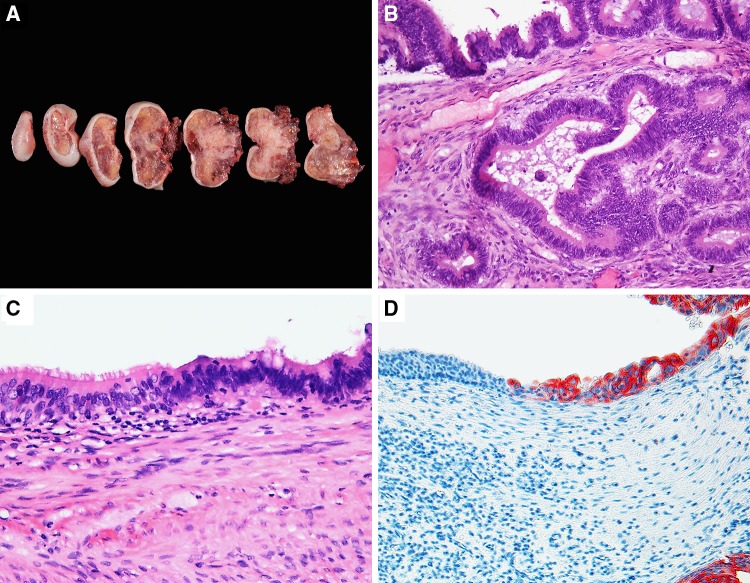Dear Editor,
We read letter to editor entitled “Colonic-type adenocarcinoma of the tongue and oral cavity (CATOC)” published on August 4th issue of Head and Neck pathology [1], and we would like to address some of the issues raised by the author.
First, the subject and the contents presented in support of the author’s view have previously been published almost a decade ago [2]. Since then the current letter provides no new evidence that sustain a derivation of this entity from preexisting structure. The suggestion made that lack of thorough sampling and in toto processing underlie failure to identify embryonic or dysontogenic precursors in reported examples is purely speculative, considering the author’s own illustrations in which unequivocal cystic or intestinal manifestations are discerned [1, 2]. We contend, therefore, that since, none of the published examples of this phenotype showed any evidence of a heterotopic structure and/or cystic component [3–7] a universal origin for this entity, exclusive of other plausible possibilities, is unsustainable.
The letter also states that previous reports of this phenotype failed to address their origin from cystic structure. In our early report [3] we’ve cited a well-documented case report by Volchok et al. [8] and considered a cystic origin in certain cases in the discussion. Given the uncertain derivation and diverse presentations of these tumors, a single common source for their development is unlikely. This is empirically in concert with reports of this phenotype at other uncommon head and neck sites lacking preexisting cystic/heterotopic lesions. It is our view that the majority of this phenotype is more likely arise from an early intestinal metaplasia of ductal epithelial lining as a precursor (Fig. 1). In this context, careful evaluation of adjacent histologically normal epithelium in completely resected tumors aided by lineage associated markers may be helpful in detecting precursors of these tumors. We, however, regardless of origin, would like to stress the differential diagnostic and management implications of this entity in head and neck sites.
Fig. 1.
a sequential sectioning of a tongue resection for a base of tongue tumor demonstrating an infiltrative solid mass with no evidence of cystic origin. b H&E colonic-type adenocarcinoma. c An example of metaplastic conversion of ciliated/respiratory type into intestinal type epithelial lining. d Anti-CK 20 immunostaining (red) highlights the transdifferentiated zone
Finally, we maintain that origin of these tumors is variable and may include pre-existing cystic and/or heterotopic alterations in normal structures and that the jury is still out on a definitive answer.
Compliance with Ethical Standards
Conflict of interest
The author declares that she has no conflicts of interest.
References
- 1.Agaimy A. Colonic-type adenocarcinoma of the tongue and oral cavity (CATOC). Head Neck Pathol. 2017:1–3. [DOI] [PMC free article] [PubMed]
- 2.Agaimy A, Raab B, Bonkowsky V, Wunsch PH. Intestinal-type adenocarcinoma arising in a congenital sublingual teratoid cyst. Virchows Arch. 2007;450(4):479–481. doi: 10.1007/s00428-007-0369-8. [DOI] [PubMed] [Google Scholar]
- 3.Bell D, Kupferman ME, Williams MD, Rashid A, El-Naggar AK. Primary colonic-type adenocarcinoma of the base of the tongue: a previously unreported phenotype. Hum Pathol. 2009;40(12):1798–1802. doi: 10.1016/j.humpath.2009.01.028. [DOI] [PMC free article] [PubMed] [Google Scholar]
- 4.McDaniel AS, Burgin SJ, Bradford CR, McHugh JB. Pathology quiz case 2 diagnosis: primary colonic-type adenocarcinoma of the tongue. JAMA Otolaryngol Head Neck Surg. 2013;139(6):653–654. doi: 10.1001/jamaoto.2013.3240a. [DOI] [PubMed] [Google Scholar]
- 5.Rahimi S, Akaev I, Repanos C, Brennan PA, Dubois JD. Primary intestinal-type adenocarcinoma of tongue: a case report with Immunohistochemical and molecular profiles and review of the literature. Head Neck Pathol. 2017;11(2):186–191. doi: 10.1007/s12105-016-0759-9. [DOI] [PMC free article] [PubMed] [Google Scholar]
- 6.Slova D, Paniz Mondolfi A, Moisini I, et al. Colonic-type adenocarcinoma of the base of the tongue: a case report of a rare neoplasm. Head Neck Pathol. 2012;6(2):250–254. doi: 10.1007/s12105-011-0301-z. [DOI] [PMC free article] [PubMed] [Google Scholar]
- 7.Smith SM, Old M, Iwenofu OH. Primary lingual colonic-type adenocarcinoma: a rare and emerging distinct entity! Head Neck Pathol. 2017;11(2):234–239. doi: 10.1007/s12105-016-0740-7. [DOI] [PMC free article] [PubMed] [Google Scholar]
- 8.Volchok J, Jaffer A, Cooper T, Al-Sabbagh A, Cavalli G. Adenocarcinoma arising in a lingual foregut duplication cyst. Arch Otolaryngol Head Neck Surg. 2007;133(7):717–719. doi: 10.1001/archotol.133.7.717. [DOI] [PubMed] [Google Scholar]



